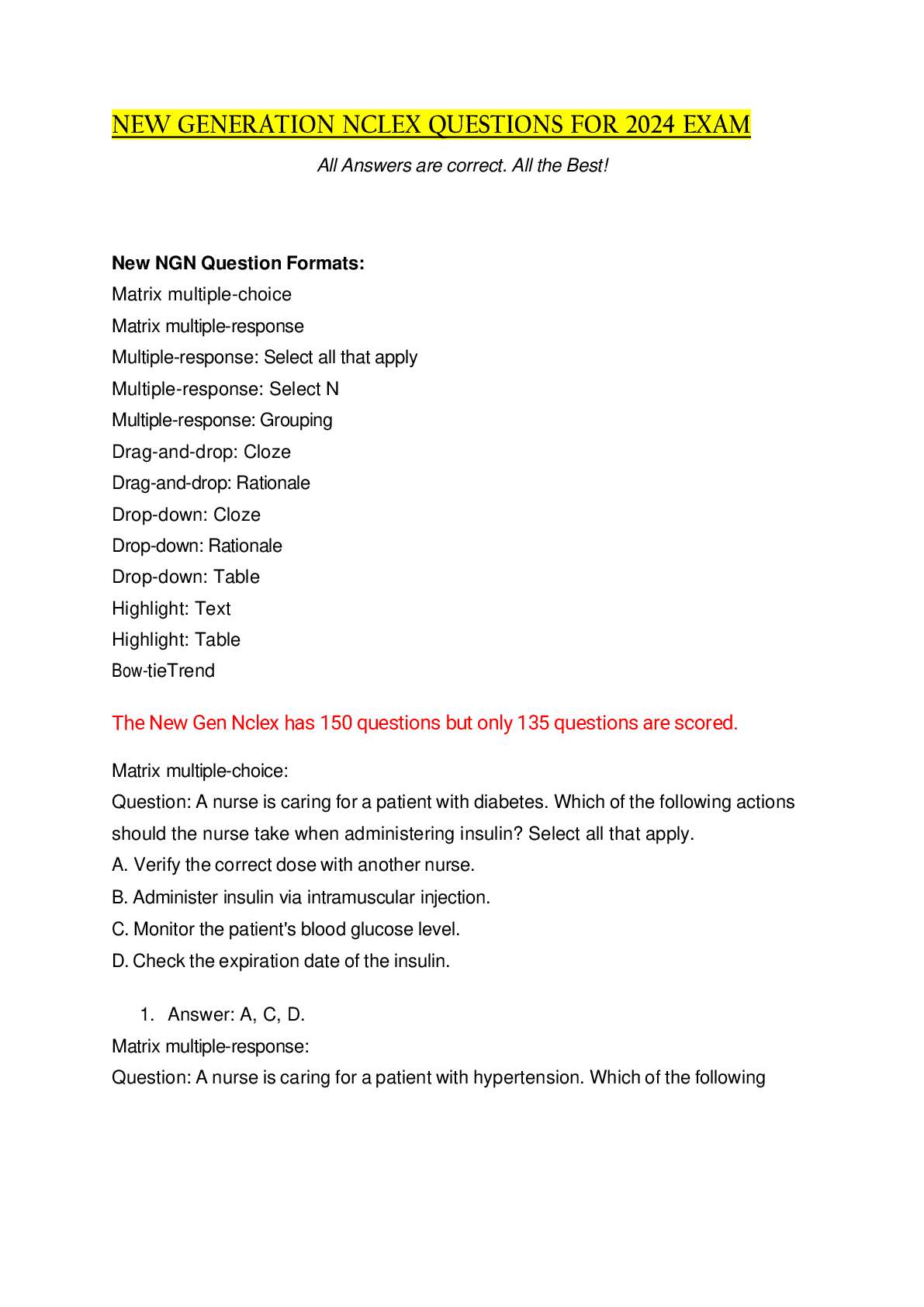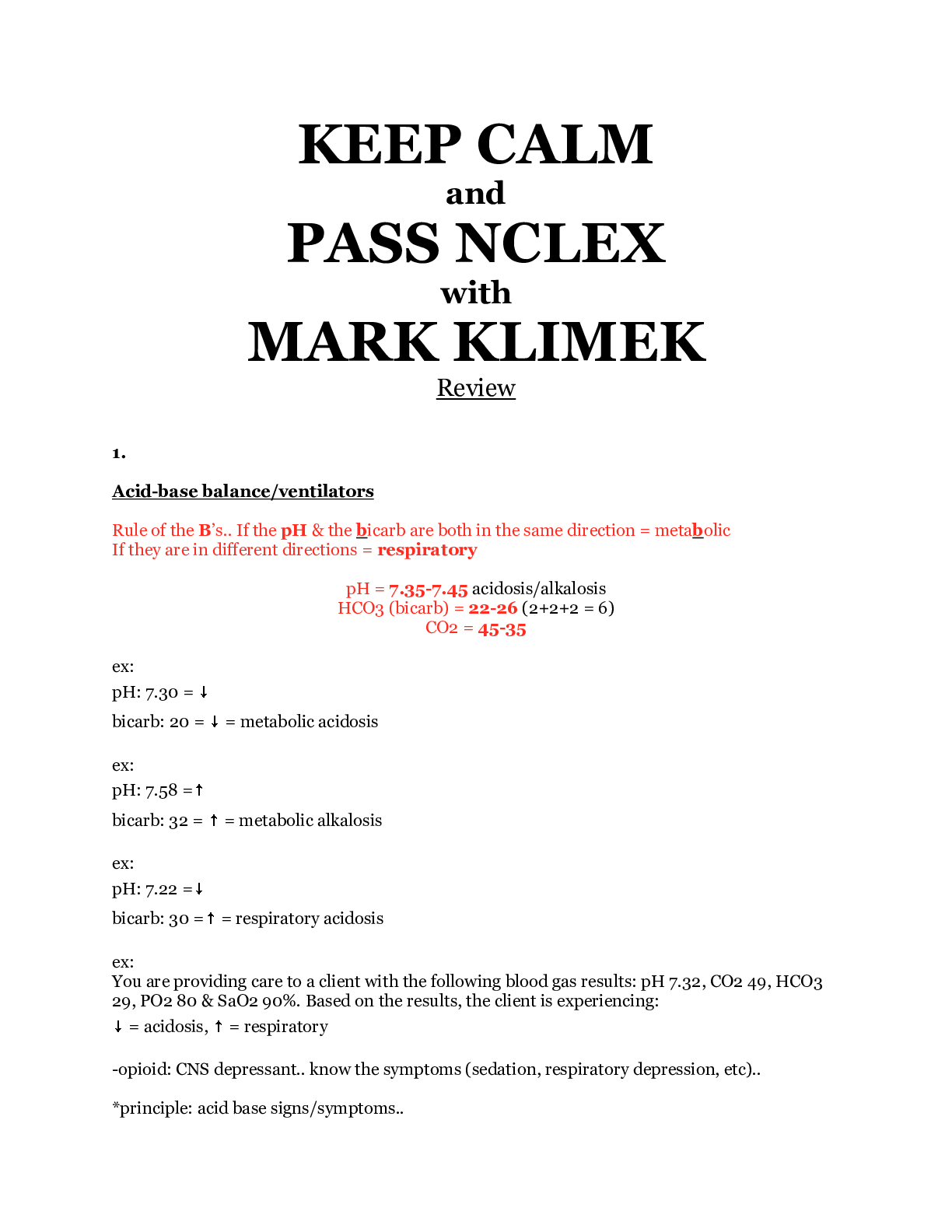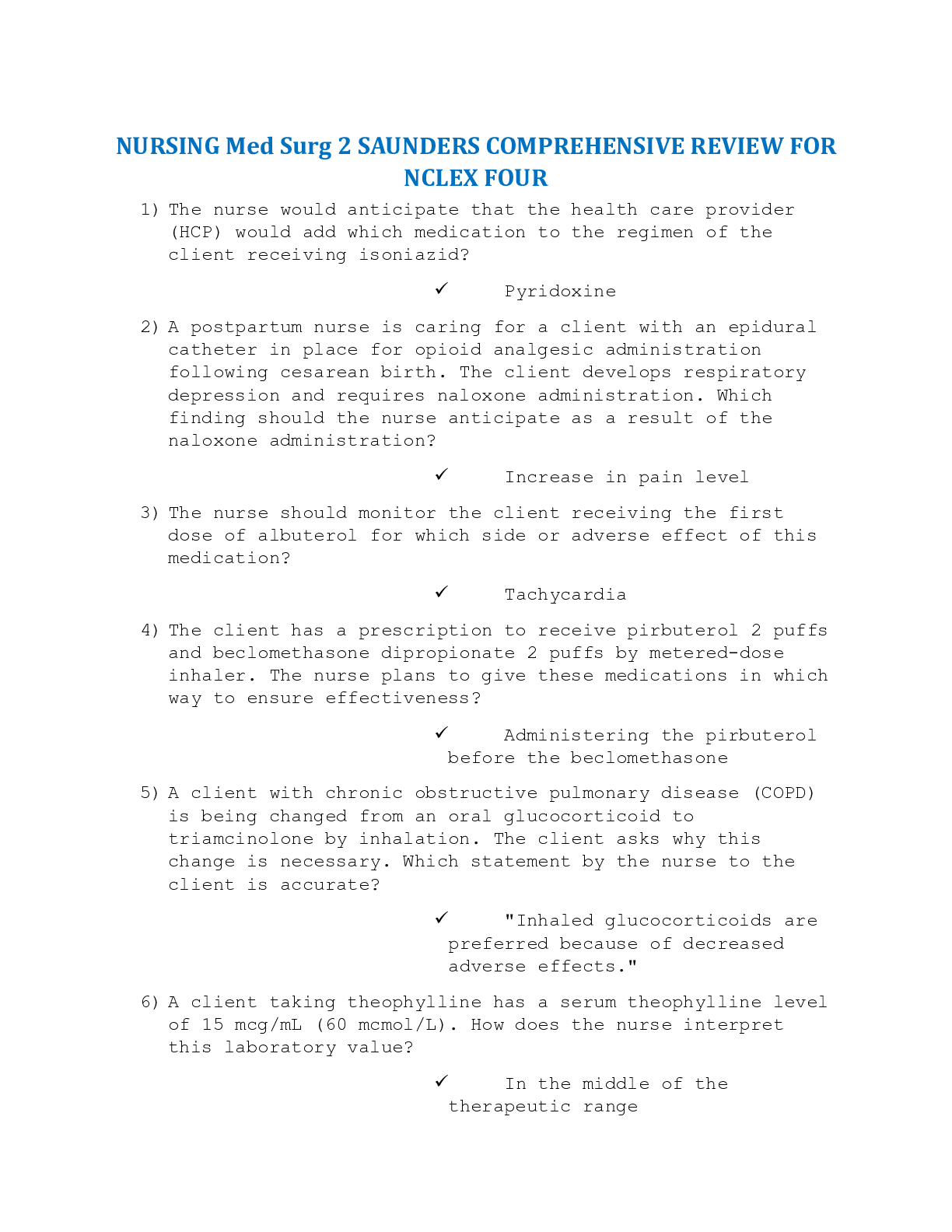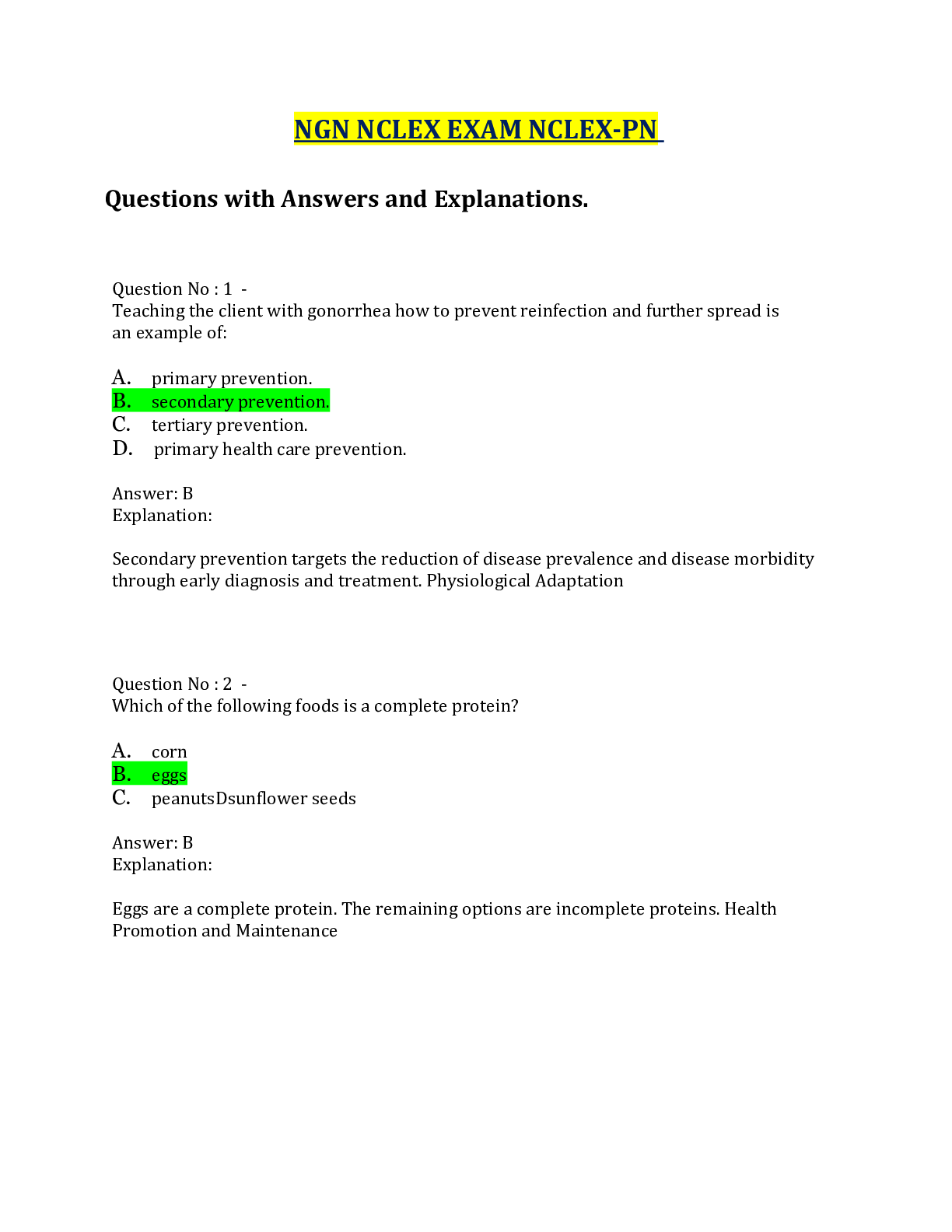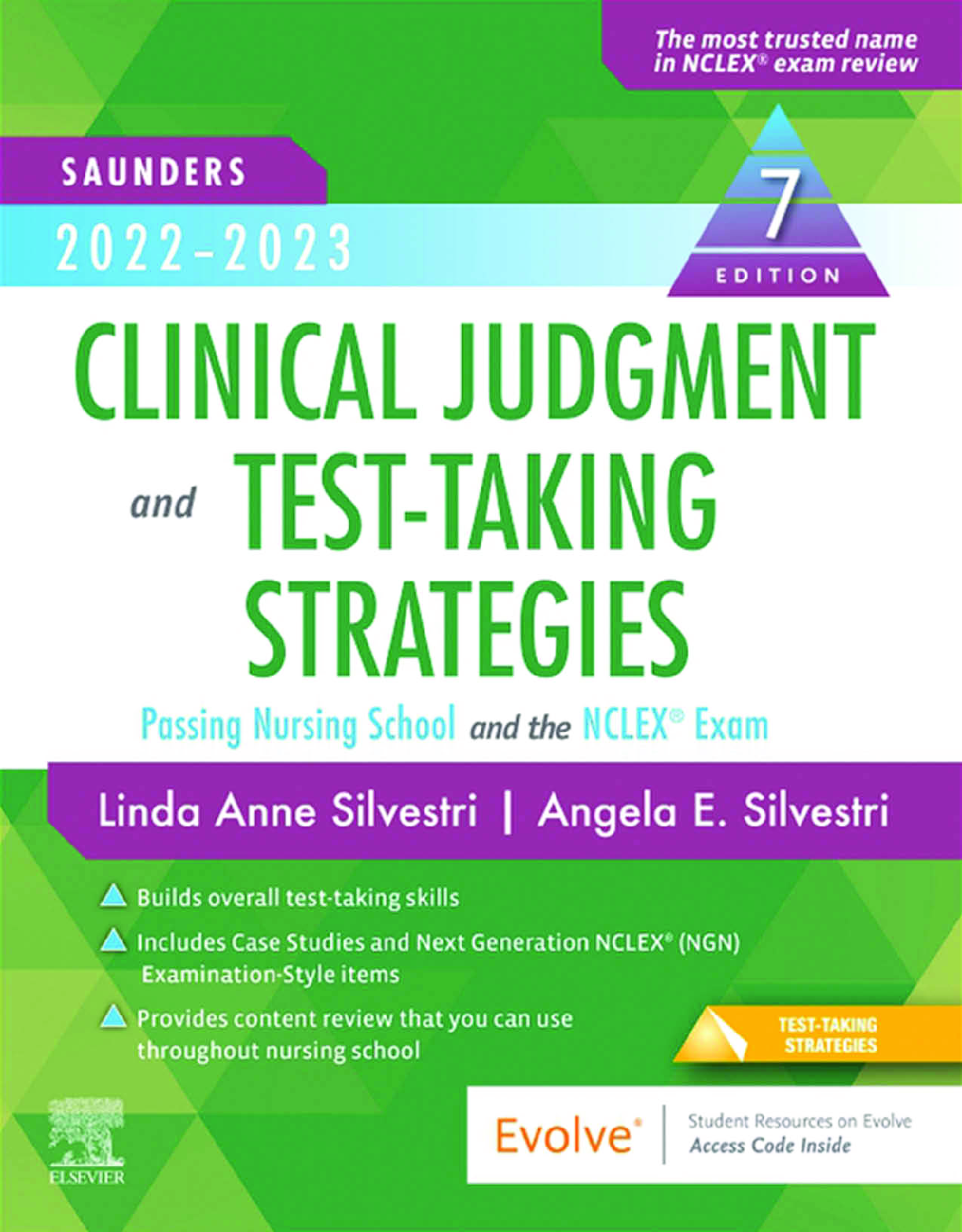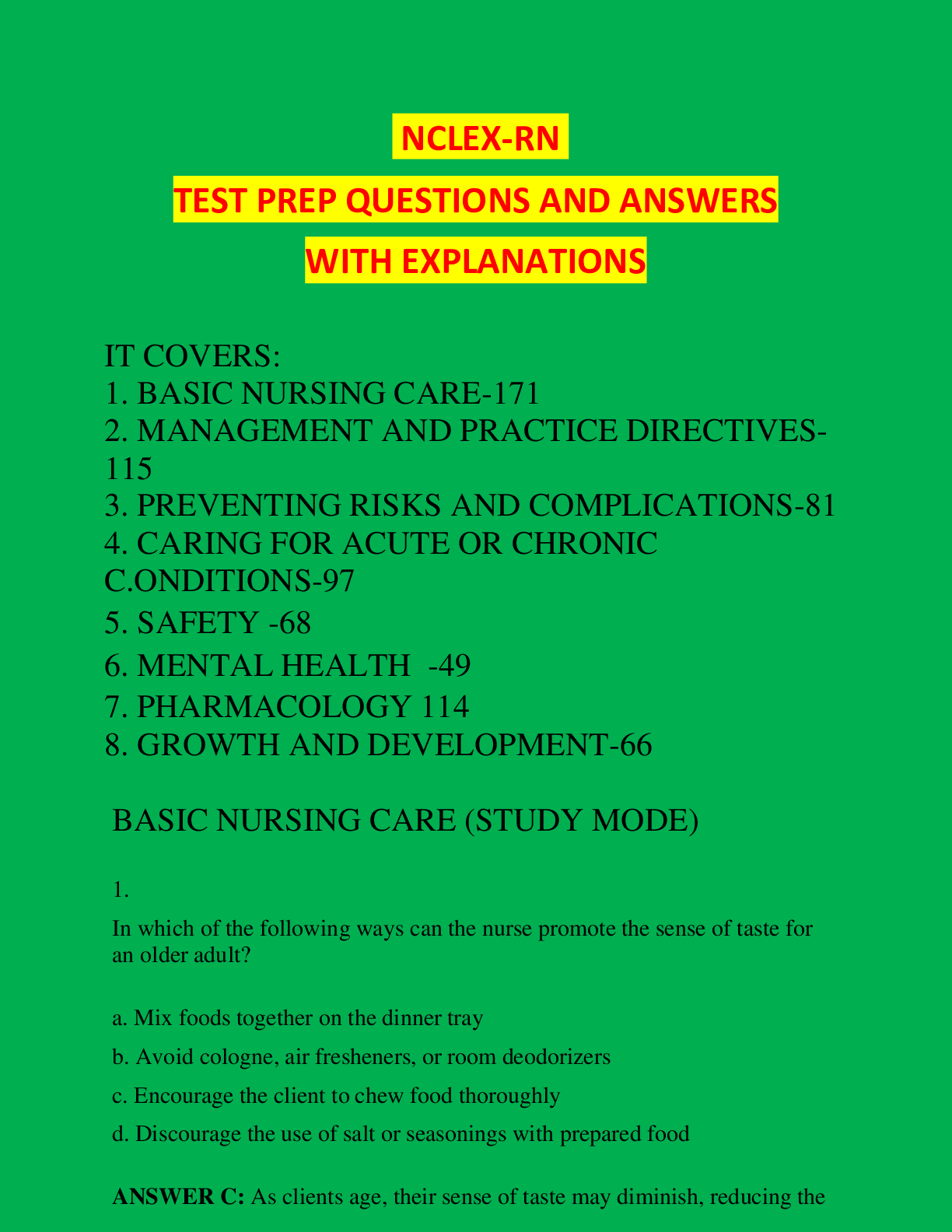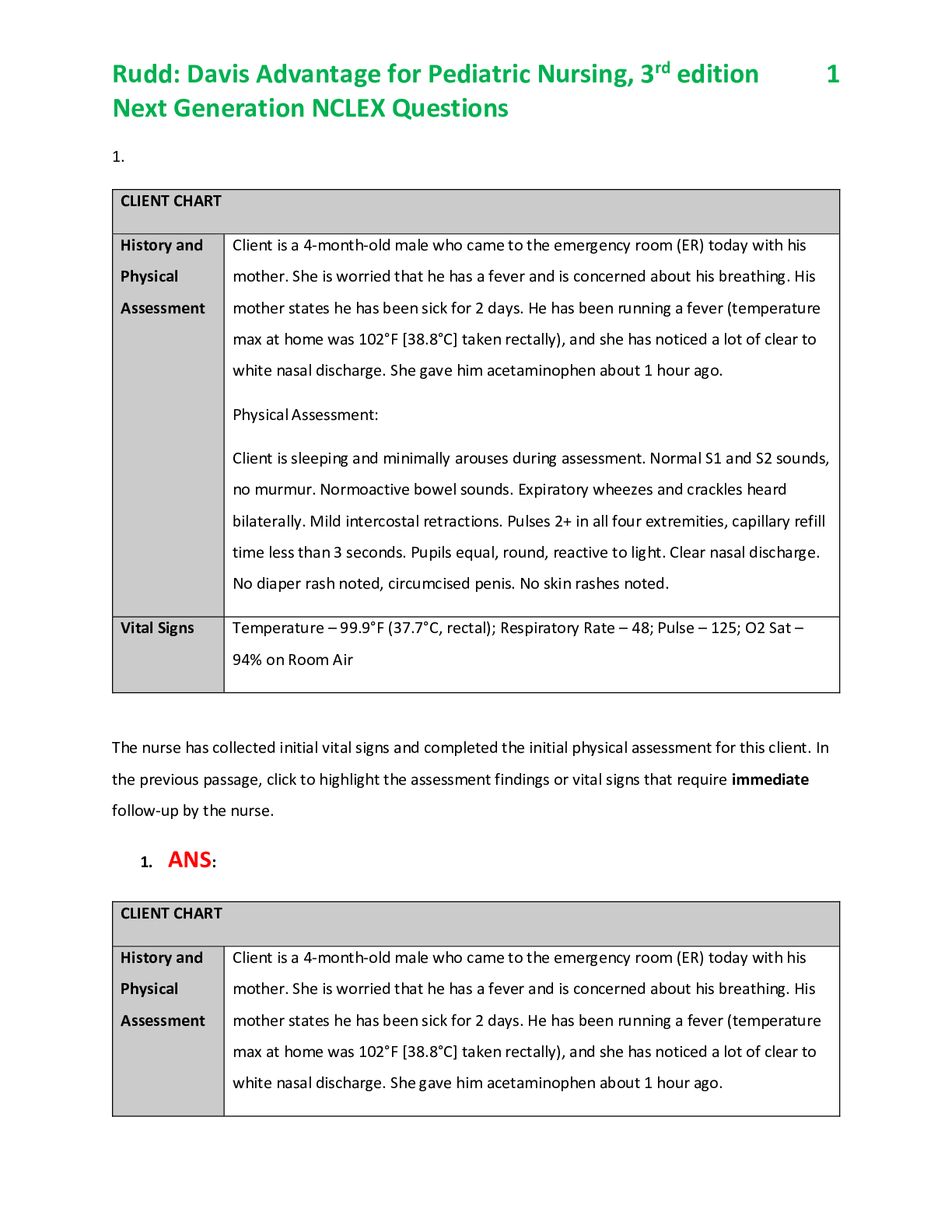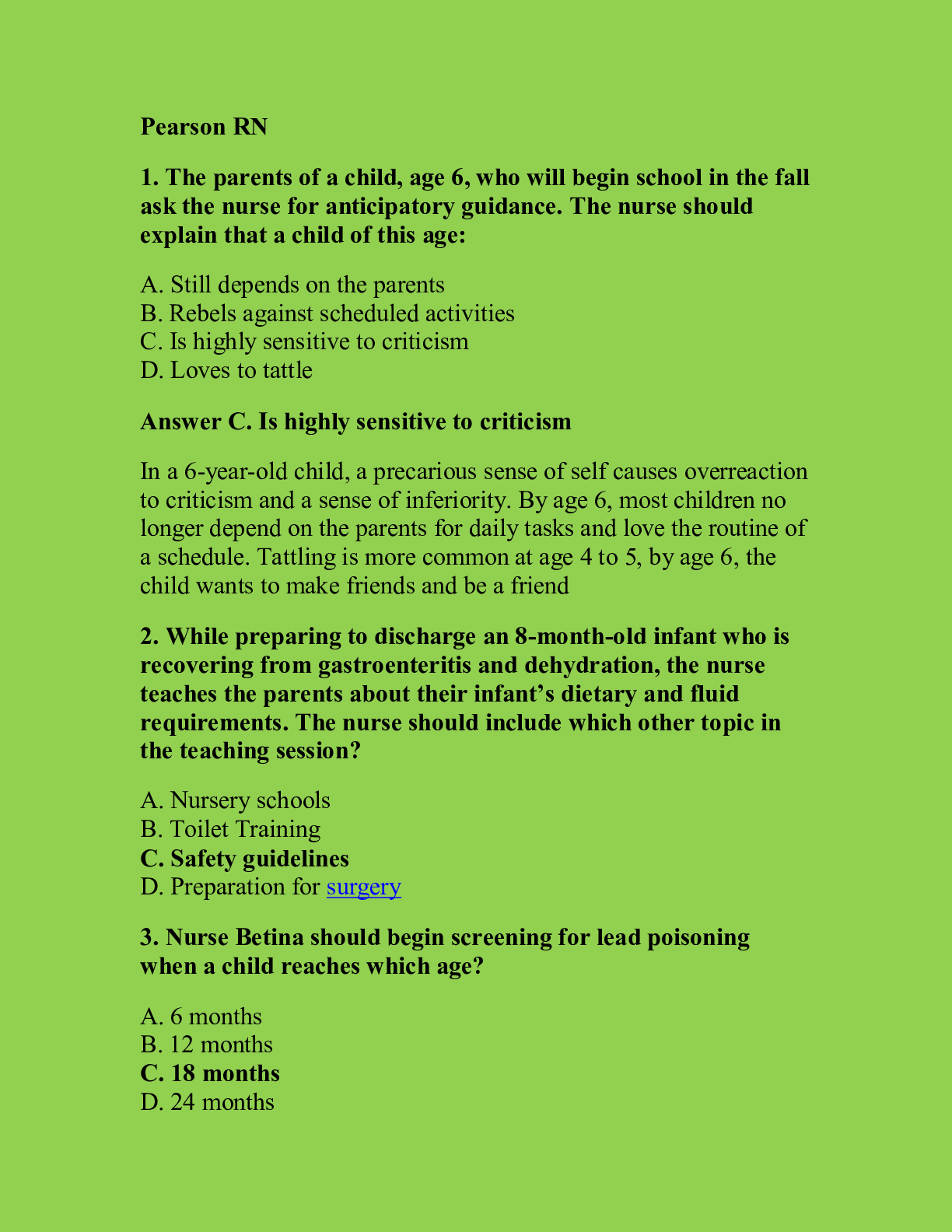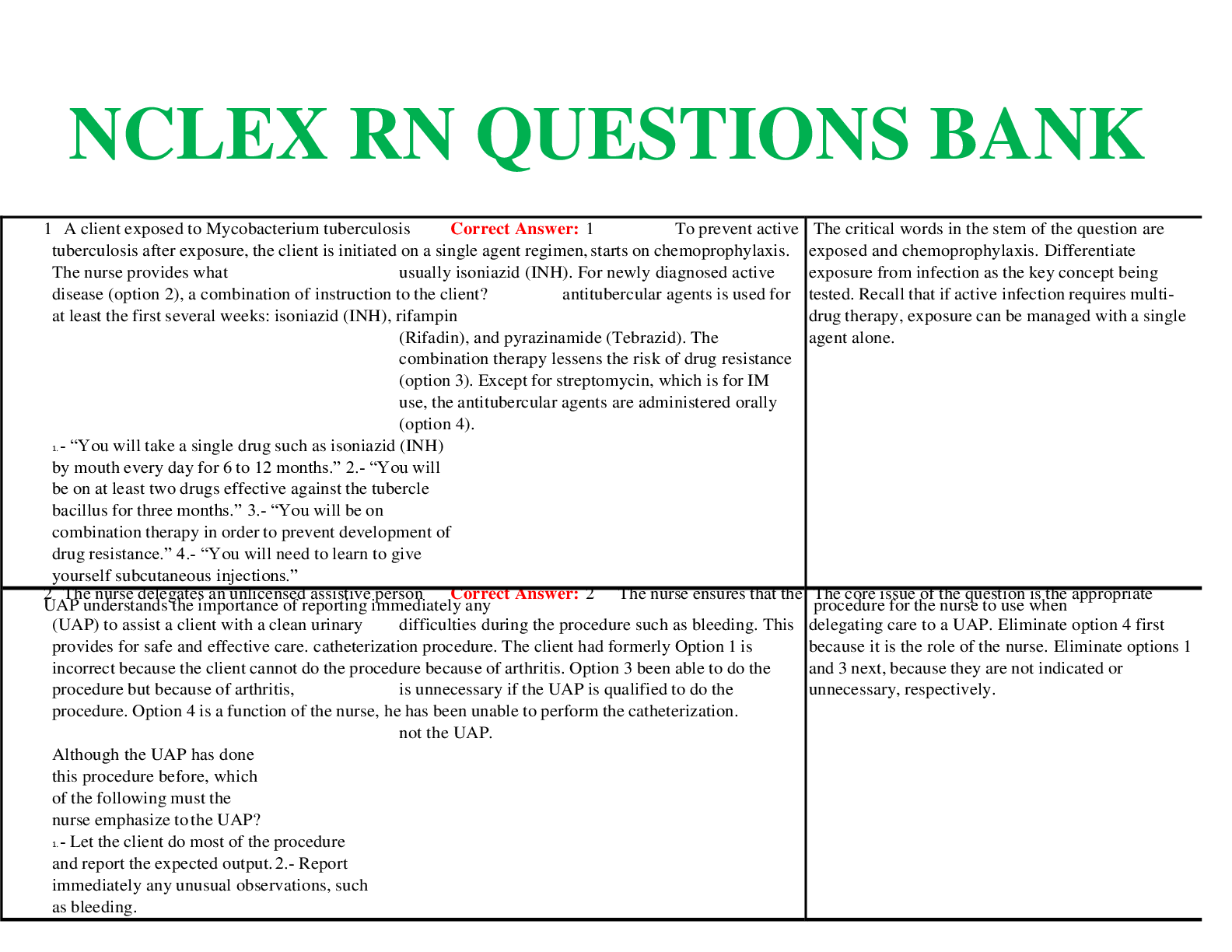Pass NCLEX 97 ( Page Guide ) BEST STUDY GUIDE EVER !! DOWNLOAD TO SCORE A+
Document Content and Description Below
Realize that the keep-open rate is the lowest possible infusion rate; this rate should not be allowed for a patient with sickle cell, as they need more hydration Realize that a child with sickle... cell should not be given aspirin because of bleeding tendencies Realize that the keep-vein-open (KVO) rate is (20 mL/h); this rate will keep access open Realize that you just keep sickle cell clients away from people with infections Realize that postoperative open heart clients should be encourage to be out of bed and ambulating as soon as possible, frequently one or two days after surgery Realize that elderly patient usually have lower temperature due to a lower basic metabolic rate Realize that an elderly client is usually intolerant to cold Realize that recognition of adult hypertension should be done after two readings taken at least five minutes apart Realize the following about a sequential compression device (SCD) Apply antiembolism stocking prior to applying the sequential compression device sleeves o Realize that stocking should be worn the entire time that client is in the hospital; it should be removed before baths and replaced after the skin is dry and before the client gets out of bed (non-ambulatory) o Realize that stocking is worn to prevent discomfort and to increase blood flow Realize that you need to be able to fit two fingers between the sleeve and the leg Realize that the SCD is used to decrease venous stasis and reduce the risk of thrombus formation Realize that if a patient has obese leg and thighs, it is not good to put elastic stocking on because it may decrease venous return because of constriction around the thigh and legs Realize that talcum powder is a toilet powder composed of perfumed; if a nurse applies it to a client’s feet, it allow easier applications of the stocking Realize that elevating the client legs before applying the stocking prevent stagnation of blood in the lower extremities Realize that when you apply the stocking, make sure that there are not wrinkles because they can cause irritation to the skin Realize the following about DVT: Realize that a patient with DVT should not be ambulating; patient should be on bedrest for 5 – 7 days to prevent pulmonary embolisms and legs should be elevated with warm moist packs Realize that the affected calf is expected to be warm Realize that extremity edema is expected because of venous congestion Realize that client needs to be given anticoagulants Realize the following about IV sites: Realize that if tenderness and redness at the IV insertion site is noted, the IV catheter should be removed to prevent further damage to the vein; and warm soaks should be applied to decrease inflammation, swelling and discomfort o Realize that reddened area with red streaks is indicative of phlebitis Realize that IV that are infiltrated should be discontinued and restarted at a new site; elevating the extremity may increase the rate of reabsorption of the fluid Realize that unused solution are always discarded; site of catheter changed every 4 weeks, change IV tubing and filers every 24 hours Realize that a marking pen should not be used on an IV bag; ink can penetrate the plastic and get into the solution; labeling should be done on the bag label using a regular pen Realize that hypertonic dextrose solution similar to TPN is used to wean patient off TPN Realize that extravasation is when a vesicant has filtrated; realize that a vesicant is a medication or IV solution that causes blisters and tissue sloughing (burning) o Realize that the following are medications that can cause a burn if infiltrated: gentatmicin, penicillin, vancomycin, dilantin, any antineoplastic, calcium, potassium and epinephrine o Realize that all infiltrations needs cool compresses except for vancomycin, which needs warm compresses Realize that if a hematoma occurs, cool compresses are needed. Realize that whenever bleeding is suspected, cool compresses is best to constrict vessels to slow down or stop the bleeding4 Realize that if IV line is clotted, it is best to just pull it and not use it; sometimes you can just dissolve the clot but this is not always recommended Realize that with a CVP, after administration of medication, flush with saline and then a heparinized solution afterwards; flush every 12 hours or after medication administration Realize that it is smart to limit manipulation of the cannula at the IV insertion site to prevent dislodgement Realize that IV sites should not be close to joints because movements could cause displacement Realize that the correct sequence for cardiac assessment is inspection, palpation and then auscultation Realize that polyarteritis nodosa is inflammation of the small arteries causing diminished blood Realize that these forms of vagal or Valsalva maneuvers can reverse SVT: Having a child stick their thumb in the mouth, close it and the blow Realize that if a patient is undergoing a septic shock and there is blood at the venipuncture site around an IV catheter, this is an indicator of dissememinated intravascular coagulation (DIC), a life-threatening problem. Realize that sepsis is the most frequent cause of DIC Realize that the reason there maybe blood around the venipuncture site is that the septic shock causes an increase in capillary permeability Realize that DIC is an acquired clotting disorder from overstimulation; prolonged oozing from sites of minor trauma first symptom Realize that disseminated intravascular coagulation (DIC) is the hyperstimulation of coagulation pathways that eventually fails, resulting in bleeding o Realize that disseminated intravascular coagulation (DIC) is not a disease, but a sign of an underlying condition o Realize that disseminated intravascular coagulation (DIC) maybe triggered by (1) sepsis, (2) trauma, (3) cancer, (4) shock, (5) abruption placentae, (6) toxins or (7) allergic reactions o Realize that in DIC, (1) the PT and PTT are prolonged and (2) the platelet count are reduced o Realize that the laboratory test that are specific for DIC are fibrin-split product (FSP)/fibrin degradation product (FDP) Realize that FDP is a group of soluble protein fragments that are produced by the proteolytic action of plasmin on fibrin or fibrinogen o Realize that clients with DIC should have oral swabs used in administering their oral care because it has the least potential cause of tissue injury in the oral cavity o Realize that clients with DIC should be protected from injury that will result in bleeding o Realize that patients with DIC may bleed from (1) mucous membrane, (2) veni-puncture sites and (3) the GI and urinary tract o Realize that during the initial process of DIC, the patients may have no new symptoms o Realize that the diagnosis of DIC is often established by (1) a drop in platelet count, (2) an increase in PT and aPTT, (3) an elevation in fibrin degradation product and (4) measurement of one or more clotting factor Realize that client diagnosed with anemia needs a diet high in protein, iron and vitamins Realize that the following foods have iron: Beef Brown rice Raisins Green beans Carrots Oatmeal-raisin Realize that hypothermia causes vasoconstriction and hypertension Realize that hypothermia causes myocardial irritability, which disrupts conduction system of the heart and causes the heart to be near the fibrillation threshold, especially ventricular fibrillation Realize that the external re-warming technique can cause re-warming shock and temperature afterdrop, which can lead to ventricular fibrillation Realize that during a paracentesis, shock may occur so a blood pressure cuff needs to be left on for monitoring5 Realize that the following are complications of paracentesis: abdominal pain, rigidity and distention, nausea and vomiting Realize that the nurse should make sure that the client voids just before a paracentesis to prevent a puncture of the bladder Realize that heat can facilitate hypotension Realize that isometric exercises such as heavy weight-lifting and rowing are contraindication in a hypertensive client Realize that a patient with a constant nose bleed needs to be told to pinch nose for 5 – 10 minutes with an ice-cold washcloth Realize that silver nitrate applicator and gelfoam may be required to stop bleeding Realize that elevated blood glucose levels places a person at risk for heart disease Realize that defibrillation should be set to 200 joules, then 200 – 300 joules, and then 360 joules; these are emergency treatment for ventricular fibrillation; completely depolarizes myocardial cells so SA nodes can reestablish as pacemaker Realize that cardio-version is the restoration of normal sinus rhythm by chemical or electrical means Realize that a sedative/hypnotic is used for sedation for the procedure Realize that digitalis must be withheld for 48 hours before procedure to prevent ventricular fibrillation after cardioversion Realize that the sync button on the defibrillator is used for cardio-version to treat the following: Atrial flutter Atrial fibrillation Supraventricular tachycardial synchronizes shock with R wave Realize that it is important not to touch the bed when using the defibrillator; it is a priority to prevent accidental countershock Realize that following a total knee replacement, surgery may interrupt blood supply to the affect extremity Realize that checking the incisional bleeding and recording the drainage is done every 4 hours Realize that after a heart attack, a male client can resume sexual activity when he can tolerate the physical activity of climbing two flights or stairs or walking one block without SOB or chest pain; patient should maintain a supine position and not have intercourse after a heavy meal Realize that a low fat and low cholesterol diet is recommended for a patient with hypertension; fried foods should be avoided; baking, roasting, boiling, or broiling are the only appropriate way of cooking for client with hypertension Realize that a patient with arteriosclerotic heart disease (ASHD) requires a diet that is low fat and low sodium. Realize that baked chicken without the skin is low in fat and sodium Realize that green vegetables low in fat and sodium Realize that hotdogs and canned soup are high in sodium Avocado is high in fat Realize that ham is high in sodium Realize that scrambled eggs, orange slices and milk have low sodium Realize that the following are risk factors of CVA: being black, being a male, substance abuse (cocaine especially), smoking, heavy alcohol use, diabetes, obesity, heart murmur, oral contraceptive use, sedentary lifestyle (job), migraines, history of myocardial infarction, elevated cholesterol Realize the following in regards to a migraine: May have throbbing headache May take ergotamines at the start of the migraine Realize that when a vascular sound or bruit (a swooshing sound) is heard over the abdominal aorta, it most often indicates aneurysm is present; physician should be notified immediately Realize that it is mandatory to check the pedal pulses after a cardiac catheterization immediately after the procedure and repeat it every 15 minutes for several hours to detect changes in circulation6 Realize that an appropriate diet for a client with hypertension is whole grains, and fresh fruits and vegatables Realize that sitting on the side of the bed enhances arterial supply of the leg Realize that elevating the leg does not increase circulation, it only promotes venous return Realize the following about Raynaud Syndrome: Realize that yoga can decrease stress that can cause vasospasms; helps increase circulation It is best to keep warm Realize that the color of the finger changes from white to blue to red and is accompanied by tingling, numbness and burning pain Realize that many medications which are ordered as IV push or bolus need to be given slowly over several minutes; with the usage of a watch Realize that a nurse should expect that the emotional response of a client with a CVA of the left hemisphere to be most influenced by his/her personality and general health prior to the CVA Realize that clients with CVA will need the following nursing care: The prevention of flexion of the affected extremities Maintain adduction of the affected shoulder to prevent deformities Client will be unable to perform active ROM, will need assistance from nurse The nurse will need to prevent external rotation of the hip joint, prevent foot drop (plantar flexion) and place the hand in slight supination so that the fingers are barely flexed… all to prevent deformities Realize that the left hemisphere of the brain controls speech, math skills analytical thinking Realize that impulsive behavior is seen with right hemisphere CVA Realize that a patient diagnosed with a CVA on the right hemisphere are often disoriented to time, place, person; has visual spatial defects; has proprioceptive (posture) difficulties, impulsive behavior, poor judgement, decreased attention span, lack of awareness or denial of neurological deficits increase risk of injury Determine if client needs assistance with eating as difficulty in eating causes severe anxiety in CVA clients Assist client in ambulating Realize that you must speak to client using phrases and short sentences, as it will decrease tension and anxiety; client may understand some of the incoming communication if it is kept simple; speech may be re-learned with appropriate support and interventions Realize that disorientation to person, place and time is also seen with right hemisphere CVA Realize that the following may occur from a CVA: Impaired motor skills Lack of coordination Mood change Realize the following about autologous blood donation: Realize that the donor may give own blood up to 5 weeks before surgery Realize that the donor will have to begin oral iron supplements, at least before the first transfusion Realize that the donor can give 2 – 4 units of blood Realize the following in regards to blood transfusion: Realize that a hemolytic reaction to blood transfusion may be a lower backache, hypotension, fever, vomiting, nausea, hematuria; transfusion must be stopped Realize that a febrile reaction to blood transfusion is a fever, chills, nausea, headache; treatment is the stop blood and administer aspirin Realize that an allergic reaction to blood transfusion is urticara (hives), pruritus, fever, wheezing, facial flushing, epiglottal edema ; treatment is to stop blood, give benadryl and administer oxygen Realize that a circulatory overload to blood transfusion, the transfusion needs to stop, position client upright and administer oxygen [Show More]
Last updated: 1 year ago
Preview 1 out of 97 pages
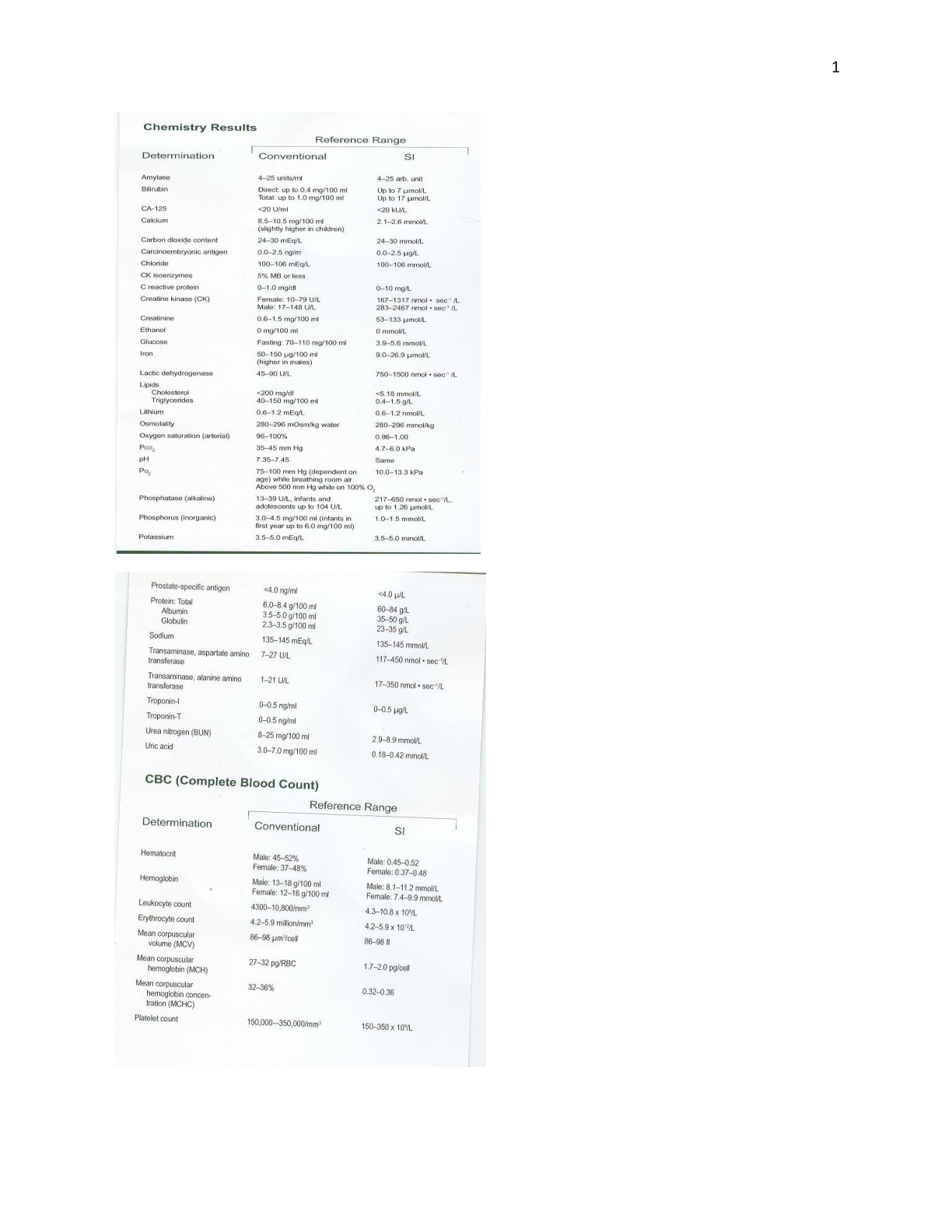
Also available in bundle (1)
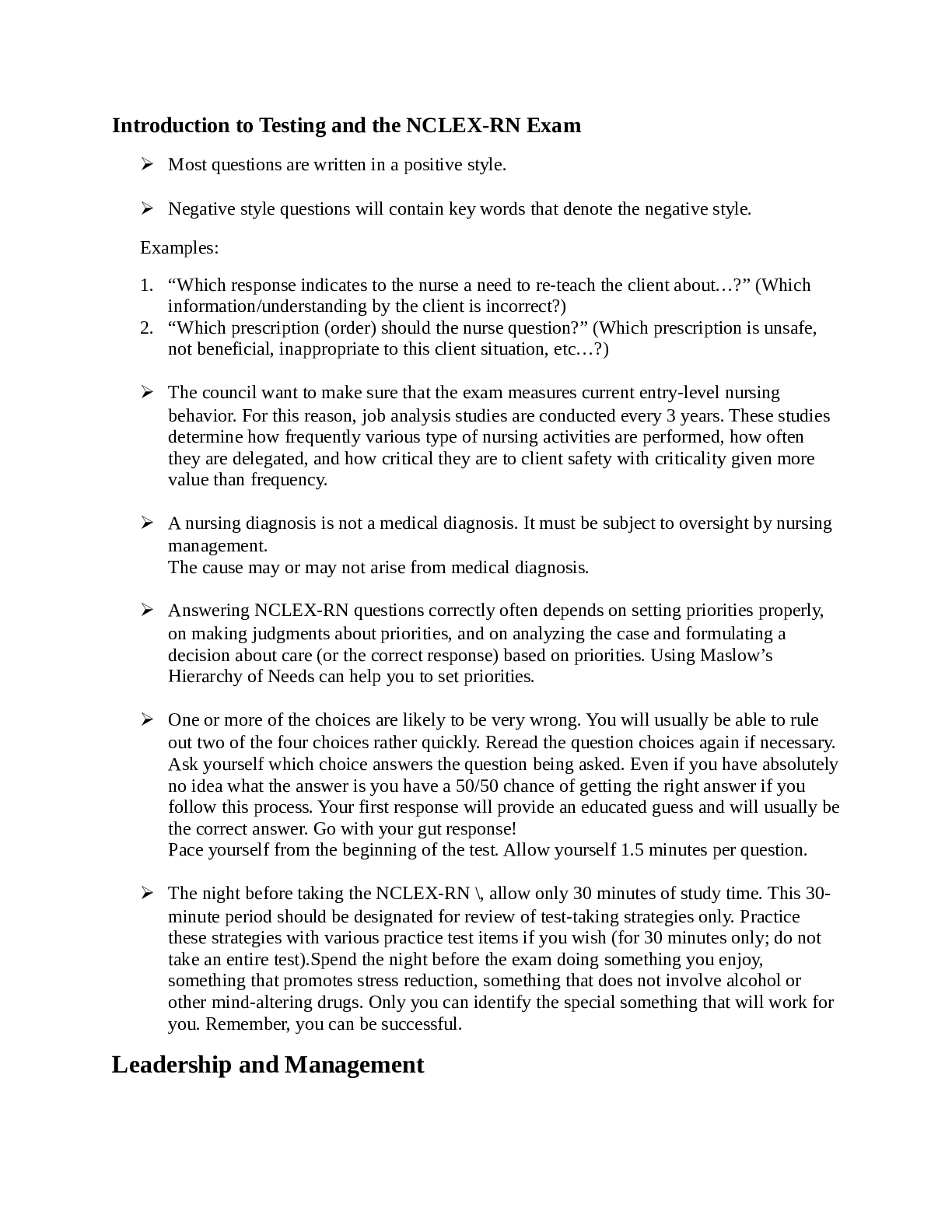
NCLEX-RN
NCLEX-RN
By Muchiri 3 years ago
$20
4
Reviews( 0 )
Document information
Connected school, study & course
About the document
Uploaded On
Apr 21, 2021
Number of pages
97
Written in
Additional information
This document has been written for:
Uploaded
Apr 21, 2021
Downloads
1
Views
83

















